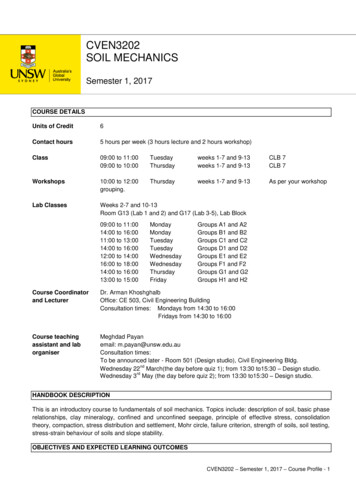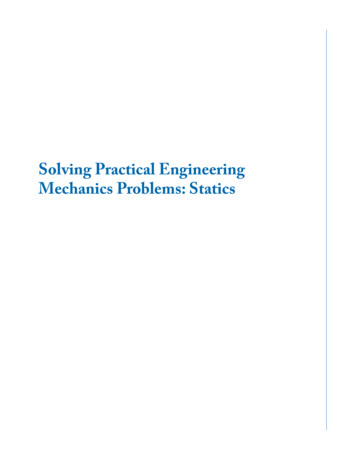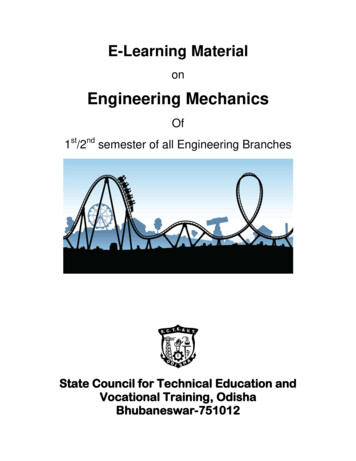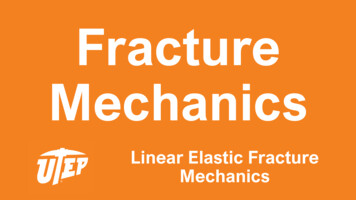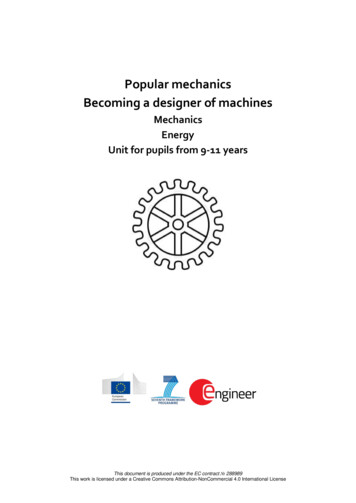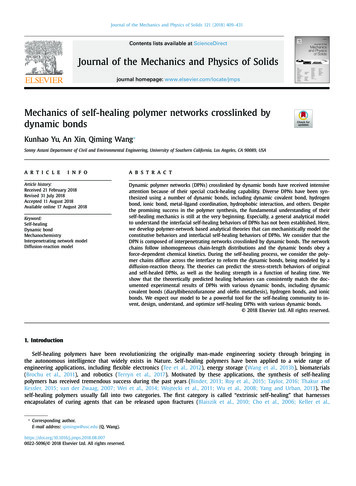
Transcription
Journal of the Mechanics and Physics of Solids 121 (2018) 409–431Contents lists available at ScienceDirectJournal of the Mechanics and Physics of Solidsjournal homepage: www.elsevier.com/locate/jmpsMechanics of self-healing polymer networks crosslinked bydynamic bondsKunhao Yu, An Xin, Qiming Wang Sonny Astani Department of Civil and Environmental Engineering, University of Southern California, Los Angeles, CA 90089, USAa r t i c l ei n f oArticle history:Received 21 February 2018Revised 31 July 2018Accepted 11 August 2018Available online 17 August 2018Keyword:Self-healingDynamic bondMechanochemistryInterpenetrating network modelDiffusion-reaction modela b s t r a c tDynamic polymer networks (DPNs) crosslinked by dynamic bonds have received intensiveattention because of their special crack-healing capability. Diverse DPNs have been synthesized using a number of dynamic bonds, including dynamic covalent bond, hydrogenbond, ionic bond, metal-ligand coordination, hydrophobic interaction, and others. Despitethe promising success in the polymer synthesis, the fundamental understanding of theirself-healing mechanics is still at the very beginning. Especially, a general analytical modelto understand the interfacial self-healing behaviors of DPNs has not been established. Here,we develop polymer-network based analytical theories that can mechanistically model theconstitutive behaviors and interfacial self-healing behaviors of DPNs. We consider that theDPN is composed of interpenetrating networks crosslinked by dynamic bonds. The networkchains follow inhomogeneous chain-length distributions and the dynamic bonds obey aforce-dependent chemical kinetics. During the self-healing process, we consider the polymer chains diffuse across the interface to reform the dynamic bonds, being modeled by adiffusion-reaction theory. The theories can predict the stress-stretch behaviors of originaland self-healed DPNs, as well as the healing strength in a function of healing time. Weshow that the theoretically predicted healing behaviors can consistently match the documented experimental results of DPNs with various dynamic bonds, including dynamiccovalent bonds (diarylbibenzofuranone and olefin metathesis), hydrogen bonds, and ionicbonds. We expect our model to be a powerful tool for the self-healing community to invent, design, understand, and optimize self-healing DPNs with various dynamic bonds. 2018 Elsevier Ltd. All rights reserved.1. IntroductionSelf-healing polymers have been revolutionizing the originally man-made engineering society through bringing inthe autonomous intelligence that widely exists in Nature. Self-healing polymers have been applied to a wide range ofengineering applications, including flexible electronics (Tee et al., 2012), energy storage (Wang et al., 2013b), biomaterials(Brochu et al., 2011), and robotics (Terryn et al., 2017). Motivated by these applications, the synthesis of self-healingpolymers has received tremendous success during the past years (Binder, 2013; Roy et al., 2015; Taylor, 2016; Thakur andKessler, 2015; van der Zwaag, 2007; Wei et al., 2014; Wojtecki et al., 2011; Wu et al., 2008; Yang and Urban, 2013). Theself-healing polymers usually fall into two categories. The first category is called “extrinsic self-healing” that harnessesencapsulates of curing agents that can be released upon fractures (Blaiszik et al., 2010; Cho et al., 2006; Keller et al., Corresponding author.E-mail address: qimingw@usc.edu (Q. 22-5096/ 2018 Elsevier Ltd. All rights reserved.
410K. Yu et al. / Journal of the Mechanics and Physics of Solids 121 (2018) 409–431Table 1Research status of self-healing soft polymers with dynamic bonds.MechanismRepresentative referenceExperimentSimulationAnalytical modelDynamic covalentbond(Chen et al., 2002; Ghosh andUrban, 2009; Imato et al., 2012;Lu and Guan, 2012; Skene andLehn, 2004)(Chen et al., 2012; Cordieret al., 2008; Montarnal et al.,2009; Phadke et al., 2012;Sijbesma et al., 1997; Wanget al., 2013a)(Das et al., 2015; Haraguchiet al., 2011; Ihsan et al., 2016;Mayumi et al., 2016; Sun et al.,2012; Sun et al., 2013; Wanget al., 2010)(Burnworth et al., 2011;Holten-Andersen et al., 2011;Kersey et al., 2007; Nakahataet al., 2011; Rowan and Beck,2005; Wang et al., 2013b),(Liu et al., 2017a; Liu et al.,2017b)(Gulyuz and Okay, 2014; Okay,2015)(Fox et al., 2012)(Haraguchi, 2007, 2011a, b;Haraguchi et al., 2007;Haraguchi and Li, 2005;Haraguchi and Takehisa, 2002;Haraguchi et al., 2011; Huanget al., 2007; Wang et al., 2010).YesNoThis paperYesNoThis paperYesNoThis paperYesNoNoYesNoNoYesNoNoYesYesNo(Balazs, 2007; Iyeret al., 2013)No(Wang et al., 2017)Hydrogen bondIonic ydrophobicassociationπ -π stackingNanoparticle2007; Toohey et al., 2007; White et al., 2001). These curing agents can help glue the fractured interfaces, thus restoringthe mechanical property of the polymer. The second category is so-called “intrinsic self-healing” which harnesses dynamicbonds that can autonomously reform after fracture or dissociation. The dynamic bonds (Table 1) include dynamic covalentbonds (Chen et al., 2002; Ghosh and Urban, 2009; Imato et al., 2012; Lu and Guan, 2012; Skene and Lehn, 2004), hydrogenbonds (Chen et al., 2012; Cordier et al., 2008; Montarnal et al., 2009; Phadke et al., 2012; Sijbesma et al., 1997; Wang et al.,2013a), ionic bonds (Das et al., 2015; Haraguchi et al., 2011; Ihsan et al., 2016; Mayumi et al., 2016; Sun et al., 2012; Sunet al., 2013; Wang et al., 2010), metal-ligand coordinations (Burnworth et al., 2011; Holten-Andersen et al., 2011; Kerseyet al., 2007; Nakahata et al., 2011; Rowan and Beck, 2005; Wang et al., 2013b), host-guest interactions (Liu et al., 2017a, b),hydrophobic interactions (Gulyuz and Okay, 2014; Okay, 2015), and π –π stacking (Fox et al., 2012).Despite the great success in synthesis and applications of self-healing polymers, the fundamental understanding andtheoretical modeling have been left behind (Table 1) (Hui and Long, 2012; Long et al., 2014; Wool, 2008; Yang and Urban,2013). Scaling models have been proposed for the interpenetration of polymer melts (Wool and O’connor, 1981; Wool, 1995,2008). In more recent years, molecular dynamics simulations have been employed to capture the healing properties (Balazs,2007; Ge et al., 2014; Stukalin et al., 2013; Zhang and Rong, 2012). However, how to construct an analytical theory formodeling the physical process of the polymer networks crosslinked by various dynamic bonds is still elusive. Yu et al.(2006a) reported an analytical theory to model the interfacial welding of a polymer under relatively high temperatures;however, the welding is different from interfacial self-healing in that self-healing behaviors usually occur at relatively lowtemperatures. In addition, Wang et al. (2017) proposed a diffusion-governed self-healing mechanics theory to model theinterfacial self-healing behaviors of nanocomposite hydrogels; however, the model is specifically designed for self-healingnetworks crosslinked by nanoparticles (Carlsson et al., 2010; Haraguchi, 2007, 2011a, b, 2003 ; Haraguchi and Li, 2006;Haraguchi et al., 2007; Haraguchi and Li, 2005; Haraguchi and Song, 2007; Haraguchi and Takehisa, 2002; Haraguchi et al.,2002, 2011; Huang et al., 2007; Ren et al., 2011; Wang et al., 2010). The understanding of general self-healing networkscrosslinked by general dynamic bonds remains elusive. The missing of this theoretical understanding would significantlydrag down the innovation of self-healing polymers to achieve their optimal self-healing performance.Here, we consider general polymer networks crosslinked by dynamic bonds, named as dynamic polymer networks(DPNs). We model a typical healing experiment of a DPN polymer in Fig. 1. A DPN polymer with dynamic bonds in a rodsample-shape is first cut/broken into two parts, and then immediately brought into contact for a certain period of healingtime. The self-healed sample is then uniaxially stretched until the sample fracture. The key process of this healing experiment is the interpenetration and bond-reformation of polymer chains with dynamic bonds around the healing interface.Here, we develop polymer-network based analytical theories that can mechanistically model the constitutive behaviors andinterfacial self-healing behaviors of DPNs. We consider that the DPN is composed of interpenetrating networks crosslinked
K. Yu et al. / Journal of the Mechanics and Physics of Solids 121 (2018) 409–431411Fig. 1. Schematics to show the process of a typical self-healing experiment. An original sample is first cut/broken into two parts and then brought intocontact for a healing time. Subsequently, the sample is stretched to measure the healing performance.by dynamic bonds. The network chains follow inhomogeneous chain length-distributions and the dynamic bonds obey aforce-dependent chemical kinetics. During the self-healing process, we consider the polymer chains diffuse across the interface to reform the dynamic bonds, which is modeled using a diffusion-reaction theory. The theories can predict thestress-stretch behaviors of original and self-healed DPNs. We show that the theoretically predicted healing behaviors canconsistently match the documented experimental results of DPNs with various dynamic bonds, including dynamic covalentbonds (diarylbibenzofuranone and olefin metathesis), hydrogen bonds, and ionic bonds. We expect our model to becomea powerful tool for the self-healing community to invent, design, understand, and optimize self-healing DPNs with variousdynamic bonds.The plan of this paper is as follows. In Section 2, we construct the theoretical frameworks for the constitutive behaviorsof the original DPNs, and the interfacial self-healing behaviors of the self-healed DPNs. In Section 3, we present the theoretical results of the models and discuss the effect of chain-length distribution, bond dynamics, and chain mobility on thetheoretical results. Section 4 focuses on three representative dynamic bonds including covalent dynamic bonds, hydrogenbond, and ionic bonds to discuss how the theoretical framework can be applied to explain the self-healing behaviors ofthese DPNs. The conclusive remarks are presented in Section 5.2. Theoretical modelsWe will introduce theoretical models to first consider the constitutive behaviors of original DPNs and then the interfacialself-healing behaviors of fractured DPNs.
412K. Yu et al. / Journal of the Mechanics and Physics of Solids 121 (2018) 409–431Fig. 2. Schematics to illustrate an interpenetrating network model. m types of networks interpenetrate in the material bulk space. The ith network iscomposed of the ith polymer chains with Kuhn segment number ni (1 i m). Each type of polymer chain self-organizes into eight-chain structures.2.1. Theory of original DPNs2.1.1. Interpenetrating network modelWe assume that the polymer is composed of m types of networks interpenetrating in the material bulk space (Fig. 2)(Wang et al., 2015). The ith network is composed of the ith polymer chains with ni Kuhn segment number. The length ofthe ith chain at the freely joint state is determined by the Kuhn segment number ni asri0 ni b(1)where b is the Kuhn Segment length. Researchers usually denote the “chain length” as ni (Rubinstein and Colby, 2003).Without loss of generality, the Kuhn segment number follows an order n1 n2 nm . We denote the number of ith chainper unit volume of material as Ni . Therefore, the total chain number per unit volume of material isN m Ni(2)i 1The chain number follows a statistical distribution asPi (ni ) NiN(3) mThe summation of the statistical distribution function is a unit, i.e.,i 1 Pi 1. This chain-length distribution is usually unknown if without a careful experimental examination. Although researchers usually accept that chain length is non-
K. Yu et al. / Journal of the Mechanics and Physics of Solids 121 (2018) 409–431413uniform but should follow a chain-length distribution as shown in Eq. (3) (Erman and Mark, 1997), the most prevailingmodel for the rubber elasticity still considers the uniform chain length, such as three-chain model, four-chain model, andeight-chain model (Arruda and Boyce, 1993; Rubinstein and Colby, 2003; Treloar, 1975). The consideration of non-uniformchain-length to model the elasticity behaviors of rubber-like materials was recently carried out by Wang et al. (2015). Because of the limited experimental technique to characterize the chain length distribution to date, the selection of chainlength distribution is still a little ambiguous. Wang et al. (2015) tested a number of chain-length distribution functions including uniform, Weibull, normal, and log-normal, and found that the log-normal distribution can best match the material’smechanical and mechanochemical behaviors. In this paper, we will simply employ the log-normal chain-length distribution(more in Sections 3 and 4), while other distributions may also work for our model.For the ith chain, if the end-to-end distance at the deformed state is ri , the chain stretch is i ri(4)ri0The free energy of the deformed ith chain can be written as wi ni kB Tβitanh βi lnβi (5)sinh βi where kB is the Boltzmann constant, T is the temperature in Kelvin, βi L 1 ( i / ni ) and L 1 () is the inverse Langevinfunction. Considering the chain as an entropic spring, the force within the deformed ith chain can be written asfi wi kB T βi rib(6)To link the relationship between the macroscopic deformation at the material level and the microscopic deformationat the polymer chain level, we consider an interpenetrating model as shown in Fig. 2 (Wang et al., 2015). We assume theith chains assemble themselves into regular eight-chain structures. We assume the material follows an affined deformationmodel (Rubinstein and Colby, 2003; Treloar, 1975), so that the eight-chain structures deform by three principal stretches(λ1 , λ2 , λ3 ) under the macroscopic deformation (λ1 , λ2 , λ3 ) at the material level. Therefore, the stretch of each ith chain is i λ21 λ22 λ23(7)3At the undeformed state, the number of ith chain per unit material volume is Ni . However, as the material is deformed,the active ith chain is decreasing because the chain force promotes the dissociation of the dynamic bonds. We assume atthe current deformed state, the number of active ith chain per unit material volume is Nia . Since every ith chain undergoesthe same stretch i , the total free energy of the material per unit volume isW m Nia ni kB Ti 1βitanh βi ln βi(8)sinh βi where βi L 1 ( i / ni ) and i is given in Eq. (7). Note that we ignore the chain entanglement effect in this interpenetration model and the following self-healing model; the entanglement contribution to hyperelastic materials can be found inother works, such as (Davidson and Goulbourne, 2013; Khiêm and Itskov, 2016; Li et al., 2016; Xiang et al., 2018).If the material is incompressible and uniaxially stretched with three principal stretches (λ1 λ, λ2 λ3 λ 1/2 ), thenominal stress along λ1 direction can be written as mλ λ 2 kB T s1 Nia ni L 13λ2 6λ 1 i 1 λ2 2λ 13ni(9)2.1.2. Association-dissociation kinetics of dynamic bondsNext, we consider the association-dissociation kinetics of dynamic bonds (Fig. 3). We model the bond association anddissociation as a reversible chemical reaction (Hänggi et al., 1990; Kramers, 1940). The forward reaction rate (from associatedfstate to dissociated state) is ki and reverse reaction rate is kri . For simplicity, we assume that only two ends of a chain haveending groups for the dynamic bond (Stukalin et al., 2013). If two end groups are associated, we consider this chain as“active”; otherwise, the chain is “inactive”. A chemical reaction shown in Fig. 3a averagely involves one polymer chain; thatis, the chemical reaction represents the transition between an active chain and an inactive chain. Here we denote the activeith chain per unit volume is Nia and the inactive ith chain per unit volume is Nid . The chemical kinetics can be written asdNia kif Nia kri Niddt(10)Since the total number of ith chain per unit volume defined as Ni Nia Nid , the chemical kinetics can be rewritten as dNia kif kri Nia kri Nidt(11)
414K. Yu et al. / Journal of the Mechanics and Physics of Solids 121 (2018) 409–431Fig. 3. (a) Schematic to show the association-dissociation kinetics of the dynamic bond on the ith chain. We consider the reaction from associated stateto dissociated state as the forward reaction of the ith chain with reaction rate kif (1 i m), and corresponding reaction from the dissociated state toassociated state as the reverse reaction with reaction rate kri . (bc) Potential energy landscape of the reverse reaction of the dynamic bond on the ith chainwith chain force (b) f i 0 and (c) fi 0. “A” stands for the associated state, “D” stands for the dissociated state, and “T” stands for the transition state.
K. Yu et al. / Journal of the Mechanics and Physics of Solids 121 (2018) 409–431f415f0At the as-fabricated undeformed state, the reaction rates are ki ki and kri kr0, respectively. As the material is fabriicated as an integrated solid, we simply assume the association reaction is much stronger than the dissociation reaction atf0the fabricated state, i.e., ki kr0. Therefore, most of the ith chains are at the associated state, as the equilibrium value ofiNia at the undeformed state isNia kr0ikr0iNi Ni kif 0(12)At the deformed state, the ith chain is deformed with stretch i . Since the bond strength of the dynamic bonds is muchweaker than those of the permanent bonds such as covalent bonds, the chain force would significantly alter the bondingreaction (Hänggi et al., 1990; Kramers, 1940). Specifically, the chain force tends to pull the bond open to the dissociatedstate. This point has been well characterized by Bell model for the ligand-receptor bonding for the cell adhesion behaviors,as well as for biopolymers (Bell, 1978). We here adopt the Bell-like model and consider the energy landscape between theassociated state and dissociated state as shown in Fig. 3b (Wang et al., 2015). We consider an energy barrier exists betweenthe associated state (denoted as “A”) and dissociated state (“D”) through a transition state (“T”). At the undeformed stateof the ith chain, the energy barrier for A D transition is Gf and the energy barrier for D Atransition is Gr . Underthe deformed state of the ith chain, the chain force fi lowers down the energy barrier of A D transition to G f fi xand increases the energy barrier for D A transition to Gr fi x, where x is the distance along the energy landscapecoordinate (Fig. 3c). Since the occurrence of the chemical reaction requires the overcoming of the energy barriers, the higherenergy barrier is corresponding to the lower likelihood of the reaction. According to the Bell model, the reaction rates aregoverned by the energy barrier through exponential functions as (Bell, 1978; Ribas-Arino and Marx, 2012). kif A exp kri B exp G f f i xkB T G r f i x kif 0exp f i xkB T kr0i exp kB T f i xkB T(13a) (13b)Where A and B are constants and x is treated as a fitting parameter for a given material.We first consider the initially-undeformed material is suddenly loaded with a deformation state (λ1 λ, λ2 λ3 λ 1/2 ) at t 0 and then deformation remains constant. The reaction rates are time-independent. Therefore, the active ithchain number per unit material volume can be calculated as Nia exp t 0 kif 0 expt0 τ exp 0f i xkB T kr0i exp kr0exp fki Tx Niikif 0 exp f i x kB TBf i xkB T dτ kr0exp fki Txi Bdς dτ Ni(14)In Eq. (14), the force fi in the ith chain is constant. Therefore, we can rewrite Eq. (14) as kr0exp fki Tx kif 0 exp fki Tx exp kif 0 exp fki Tx kr0exp fki TxNiaiiBBBB Nik f 0 exp fi x kr0 exp fi xkB Ti t(15)kB TiOver a period of loading time, the active ith chain number per unit volume Nia in Eq. (15) decreases from Ni to a plateau with a value Ni kr0exp ifi xkB T f0/ ki exp fi xkB T kr0exp ifi xkB T (Fig. 4a). The required timescale is the characteristic timescale of the chemical reaction.If the material is loaded with increasing stretch (λ1 λ, λ2 λ3 λ 1/2 ), the chemical reaction rates are both timedependent. In solving the chemical kinetics, we have to consider the time-dependent behavior of the reaction rates andsolve the equation numerically. In a more common case, we apply the load with a very small loading rate, so that thedeformation of the material is usually assumed as quasi-static. It means that in every small increment of the load, thechemical reaction already reaches its equilibrium state with an equilibrium active ith chain numberNia . Under this condition,the active ith chain number per unit material volume is expressed as Nia Ni kr0exp fki Txikif 0 exp f i x kB TB kr0exp fki Txi (16)Bwith the chain force fi as expressed in Eq. (6). As shown in Fig. 4b, Nia decreases from Ni to near-zero at various speedsfor various chain lengths, because different chain lengths are corresponding to different chain forces. Once Nia is solved, itcan be plugged into Eq. (9) to obtain the stress-stretch behaviors of the DPNs. As shown from Eq. (16), the density of activeith chain should decrease as the chain force increases. This molecular picture is different from the dynamic polymers withbond exchange reactions, for which the density of associated bonds is assumed as constant during the network evolution(Yu et al., 2016a).
416K. Yu et al. / Journal of the Mechanics and Physics of Solids 121 (2018) 409–431Fig. 4. Examples of chain dynamics behaviors. (a) The active ith chain number in functions of the loading time of various constant uniaxial stretch. (b)The active ith chain number of various chain length ni in functions of the quasi-statically increasing uniaxial stretch. The used parameters can be found inTable 2.2.1.3. Additional considerationIn addition to the above association-dissociation kinetics, we also consider two supplementary points. The first one is thenetwork alteration. During the mechanical loading, a portion of dissociated short chains may reorganize to become activelong chains (Chagnon et al., 2006; Marckmann et al., 2002). To capture this effect, we follow the network alteration theoryto model the number of active chains to be an exponential function of the chain stretch i asNia exp [α ( i 1 )]Ni(17)where α is the chain alteration parameter. Similar network alteration model has been employed to model the chain reorganization for the Mullin’s effect of rubber (Chagnon et al., 2006; Marckmann et al., 2002), double-network hydrogels(Zhao, 2012), and nanocomposite hydrogels (Wang and Gao, 2016). It has been shown that the network alteration is aunique network damage mechanism that facilitates the stiffening effect of the stress-stretch curve (Chagnon et al., 2006;Marckmann et al., 2002; Wang and Gao, 2016). Since the effect of network alteration on the stress-strain behaviors of polymer networks has been clearly demonstrated in the existing literature (Wang and Gao, 2016), we would not discuss indetails about their effects in this paper, and just harness this network alteration effect to better capture the stress-stretchcurve shapes of the original DPNs.The second point is about the full dissociation when the chain length is longer than the length limit of the chain. The fully extended length of the ith chain is ni bwith a stretch as ni b/( ni b) ni . If the stretch of the ith chain is larger than ni , the dynamic bond will be fully dissociated. This can be expressed asNia 0, if i ni(18)2.2. Self-healing behavior of fractured DPNsWe consider a DPN polymer sample shown in Fig. 1. We cut the sample into two parts and then immediately contactback. After a certain period of healing time t, the sample is uniaxially stretched until breaking into two parts again. If thehealing is not fully, the breaking point will be at the healing interface; however, if the healing is close to 100%, the breakingpoint should be distributed stochastically through the whole sample. Here, we consider the self-healed sample is composedof two segments (Fig. 1). Around the healing interface, the polymer chain would diffuse across the interface to form newnetworks through forming new dynamic bonds. We call this region as “self-healed segment”. Away from the self-healedsegment, the polymer networks are intact, and we call this region as “virgin segment”.2.2.1. Behavior of the self-healed segmentAs we assume in Section 2.1.1, the ith chains form network following eight-chain structures (Fig. 5a). For simplicityof analysis, we assume the cutting position is located at a quarter part of the eight chain cube, namely the center position between a corner and the center of the eight-chain cube (Fig. 5a). The cutting process forces the polymer chains tobe dissociated from the dynamic bond around the corner or center positions. This assumption is based on the Lake-Thomastheory that assumes that the chain force is transferred through every Kuhn segment on the chain, and under the same chainforce, the dynamic bonds with much weaker strengths are expected to break sooner than the permanent bonds (Lake and
K. Yu et al. / Journal of the Mechanics and Physics of Solids 121 (2018) 409–431417Fig. 5. (a, b) Schematics of the eight-chain network model before and after the cutting process. The cutting is assumed to be located in a quarter positionof the cube. (c) A schematic to show the diffusion behavior of the ith polymer chain across the interface.Thomas, 1967). Since we immediately contact the material back, we assume the ending groups of the dynamic bonds arestill located around the cutting interface, yet without enough time to migrate into the material matrix (Fig. 5b) (Wang et al.,2017). Driven by weak interactions between ending groups of the dynamic bonds, the ending groups on the interface willdiffuse across the interface to penetrate into the matrix of the other part of the material to form new dynamic bonds.Specifically in Fig. 5b, the ending groups of the part A will penetrate into part B towards the center position of the cube,and the ending groups of part B will penetrate into Part A towards the corner positions of the cube. These interpenetrationbehaviors can be simplified as a 1D model shown in Fig. 5c. As shown in Fig. 5c, an open ending group around the interface penetrates into the other part of the material to find another open ending group to form a dynamic bond. Once thedynamic bond reforms, the initially “inactive” chain becomes “active”. This behavior can be understood as two processes:chain diffusion and ending group reaction.To model the chain diffusion, we consider a reptation-like model shown in Fig. 5c (De Gennes, 1979; de Gennes, 1971; Doiand Edwards, 1978; Rubinstein and Colby, 2003). We assume the polymer chain diffuses along its contour tube analogousto the motion of a snake. The tube diameter is assumed as much smaller than the chain length. The motion of the polymerchain is enabled by extending out small segments called “minor chains”. The curvilinear motion of the polymer chain is
418K. Yu et al. / Journal of the Mechanics and Physics of Solids 121 (2018) 409–431characterized by the Rouse friction model with the curvilinear diffusion coefficient of the ith chain written asDi kB Tni ξ(19)where ξ is the Rose friction coefficient per unit Kuhn segment. In the original reptation model, the contour length of theprimitive chain is considered as ni b2 /a, where a is a step length of the primitive chain (de Gennes, 1971; Doi and Edwards,1988). The step length a is an unknown parameter that depends on the statistical nature of the network and is of the orderof the mesh side of the network. Conceptually, we may assume a b, then the contour length of the primitive chain will beapproximated as ni b.We note that the chain motion follows a curvilinear path; therefore, we construct two coordinate systems s and y, wheres denotes the curvilinear path along the minor chains and y denotes the linear path from the interface to the other openending group. When the ith chain moves si distance along the curvilinear path, it is corresponding to yi distance along ycoordinate. Here we assume the selection of the curvilinear path is fully stochastic following the Gaussian statistics (Kim andWool, 1983; Whitlow and Wool, 1991; Zhang and Wool, 1989). Therefore, the conversion of the distances in two coordinatesystems is expressed asyi si b(20)According to the eight-chain cube assumption, the distance between the corner and the center within the ith networkcube at its freely joint state isLi ni b(21)The distance between the ending group around the interface and the other ending group in the matrix is Li /2. Accordingto Eq. (21), the positions y 0 and y Li /2 are corresponding to s 0 and s L2i /4b, respectively.If we only consider the polymer chain diffusion, the diffusion of the ith chain can be modeled with the following diffusion equation along the curvilinear coordinate s, Cid (t, s ) 2Cid (t, s ) Di t s2(22)where Cid (t, s ) is the inactive ith chain number per unit length (with unit area) along the coordinate s (0 s L2i /4b) attime t. However, the chain behavior is more complicated than just diffusion, because during the diffusion the ending groupwould encounter another ending group to undergo a chemical reaction to form a new dynamic bond. Although the chemicalreaction may only occur around the ending group within the material matrix (relatively immobile ending group ats L2i /4b),the reaction forms dynamic bonds to transit an inactive chain into an acti
(DPNs). We model a typical healing experiment of a DPN polymer in Fig. 1. A DPN polymer with dynamic bonds in a rod sample-shape is first cut/broken into two parts, and then immediately brought into contact for a certain period of healing time. The self-healed sample is then uniaxially stretched until the sample fracture.




